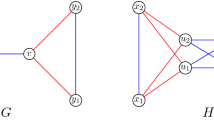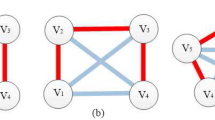Abstract
The Alon–Tarsi number was defined by Jensen and Toft (Graph coloring problems, Wiley, New York, 1995). The Alon–Tarsi number AT(G) of a graph G is the smallest integer k such that G has an orientation D with maximum outdegree \(k-1\) and the number of even circulation is not equal to that of odd circulations in D. It is known that \(\chi (G)\le \chi _l(G)\le AT(G)\) for any graph G, where \(\chi (G)\) and \(\chi _l(G)\) are the chromatic number and the list chromatic number of G. Denote by \(H_1 \square H_2\) and \(H_1\bowtie H_2\) the Cartesian product and the semi-strong product of two graphs \(H_1\) and \(H_2\), respectively. Kaul and Mudrock (Electron J Combin 26(1):P1.3, 2019) proved that \(AT(C_{2k+1}\square P_n)=3\). Li, Shao, Petrov and Gordeev (Eur J Combin 103697, 2023) proved that \(AT(C_n\square C_{2k})=3\) and \(AT(C_{2m+1}\square C_{2n+1})=4\). Petrov and Gordeev (Mosc. J. Comb. Number Theory 10(4):271–279, 2022) proved that \(AT(K_n\square C_{2k})=n\). Note that the semi-strong product is noncommutative. In this paper, we determine \(AT(P_m \bowtie P_n)\), \(AT(C_m \bowtie C_{2n})\), \(AT(C_m \bowtie P_n)\) and \(AT(P_m \bowtie C_{n})\). We also prove that \(5\le AT(C_m \bowtie C_{2n+1})\le 6\).
Similar content being viewed by others
Data availability
No datasets were generated or analyzed during the current study.
References
Alon N, Tarsi M (1992) Colorings and orientations of graphs. Combinatorica 12(2):125–134
Alon N (1999) Combinatorial Nullstellensatz. Comb Probab Comput 8(1–2):7–29
Cushing W, Kierstead HA (2010) Planar graphs are 1-relaxed, 4-choosable. Eur J Combin 31:1385–1397
Grytczuk J, Zhu X (2020) Alon–Tarsi number of planar graphs minus a matching. J Combin Theory Ser B 145:511–520
Hefetz D (2011) On two generalizations of the Alon–Tarsi polynomial method. J Combin Theory Ser B 101(6):403–414
Hladký J, Král D, Schauz U (2010) Brooks’ theorem via the Alon–Tarsi theorem. Discrete Math 310:3426–3428
Jensen T, Toft B (1995) Graph coloring problems. Wiley, New York
Kim R, Kim S-J, Zhu X (2019) The Alon–Tarsi number of subgraphs of a planar graph. arXiv:1906.01506
Kaul H, Mudrock JA (2019) On the Alon–Tarsi number and chromatic-choosability of cartesian products of graphs. Electron J Combin 26(1):P1.3
Lu H, Zhu X (2020) The Alon–Tarsi number of planar graphs without cycles and length \(4\) and \(l\). Discrete Math 343(5):111797
Li Z, Shao Z, Petrov F, Gordeev A (2023) The Alon–Tarsi number of a toroidal grid. Eur J Combin 103697
Petrov F, Gordeev A (2022) Alon-Tarsi numbers of direct products. Mosc. J. Comb. Number Theory 10(4):271–279
Schauz U (2008) Algebraically solvable problems: describing polynomials as equivalent to explicit solutions. Electron J Combin 15(1):R10
Schauz U (2014) Proof of the list edge coloring conjecture for complete graphs of prime degree. Electron J Combin 21(3):P3.43
Thomassen C (1994) Every planar graph is 5-choosable. J Combin Theory Ser B 62(1):180–181
Zhu X (2019) The Alon-Tarsi number of planar graphs. J Comb Theory Ser B 134:354–358
Zhu X, Balakrishnan R (2021) Alon–Tarsi theorem and its applications
Funding
The authors have not disclosed any funding.
Author information
Authors and Affiliations
Corresponding author
Ethics declarations
Conflict of interest
The authors have not disclosed any conflict of interest.
Additional information
Publisher's Note
Springer Nature remains neutral with regard to jurisdictional claims in published maps and institutional affiliations.
Xiangwen Li: Supported by the NSFC (12031018).
Appendix
Appendix
Procedure 1
\(f1 =(x2*x6+x2*x5+x1*x2+x1*x5+x6*x5+x1*x6)\wedge 2\)
\(f3 =56*x6*x5\wedge 3+90*x6\wedge 2*x5\wedge 2+56*x6\wedge 3*x5+16*x5\wedge 4+16*x6\wedge 4\)
\(>> diff(diff(f3,x5,2),x6,2)/factorial(2)\wedge 2\)
\(ans =90\)
Procedure 2
\(f1 =-16*x6\wedge 2*x5*x10-16*x6*x5\wedge 2*x10-16*x6\wedge 2*x5*x9+44*x6*x5*x10\wedge 2+44*x6*x5*x9\wedge 2 +44*x9*x10*x6\wedge 2+44*x9*x10*x5\wedge 2-16*x9*x10\wedge 2*x6-16*x9\wedge 2*x10*x6-16*x9*x10\wedge 2*x5 -16*x9\wedge 2*x10*x5-16*x6*x5\wedge 2*x9+16*x5\wedge 2*x9\wedge 2+16*x5\wedge 2*x10\wedge 2 +16*x6\wedge 2*x9\wedge 2+16*x6\wedge 2*x10\wedge 2+x9\wedge 2*x10\wedge 2+120*x6*x5*x9*x10+x6\wedge 2*x5\wedge 2\)
\(ans =882\)
Procedure 3
\(f1=8*x13\wedge 2*x14*x5+44*x6*x5*x13*x14+x6\wedge 2*x5\wedge 2+x13\wedge 2*x14\wedge 2+8*x13*x14\wedge 2*x5 +8*x13\wedge 2*x14*x6+8*x13*x14\wedge 2*x6+16*x5\wedge 2*x13*x14+16*x6*x5*x13\wedge 2+16*x6*x5*x14\wedge 2 +16*x6\wedge 2*x13*x14+8*x6*x5\wedge 2*x13+8*x6\wedge 2*x5*x13+8*x6*x5\wedge 2*x14+8*x6\wedge 2*x5*x14 +6*x5\wedge 2*x13\wedge 2+6*x5\wedge 2*x14\wedge 2+6*x6\wedge 2*x13\wedge 2+6*x6\wedge 2*x14\wedge 2\)
Without loss of generality, let \(t=5\).
\(f3 =D*x6\wedge 2*x5\wedge 2+4*A*x17\wedge 2*x18*x5+4*A*x17*x18\wedge 2*x5+4*A*x17\wedge 2*x18*x6+4*A*x17*x18\wedge 2*x6 +2*C*x6*x5*x17\wedge 2+2*C*x6*x5*x18\wedge 2 +4*E*x5\wedge 2*x17*x18+4*E*x6\wedge 2*x17*x18+6*B*x5\wedge 2*x17*x18+6*B*x6\wedge 2*x17*x18+2*F*x5*x6*x17\wedge 2 +2*F*x5*x6*x18\wedge 2 +4*A*x6*x5\wedge 2*x17+4*A*x6*x5\wedge 2*x18+4*A*x6\wedge 2*x5*x17+4*A*x6\wedge 2*x5*x18+D*x17\wedge 2*x18\wedge 2 +2*E*x5\wedge 2*x17\wedge 2+6*F*x5*x6*x17*x18 +4*C*x6*x5*x17*x18+2*E*x5\wedge 2*x18\wedge 2+2*E*x6\wedge 2*x17\wedge 2+2*E*x6\wedge 2*x18\wedge 2 +2*B*x5\wedge 2*x17\wedge 2+2*B*x5\wedge 2*x18\wedge 2+2*B*x6\wedge 2*x17\wedge 2 +2*B*x6\wedge 2*x18\wedge 2\)
\(>>f4=-16*x6\wedge 2*x5*x18-16*x6*x5\wedge 2*x18-16*x6\wedge 2*x5*x17+44*x6*x5*x18\wedge 2+44*x6*x5*x17\wedge 2 +44*x17*x18*x6\wedge 2 +44*x17*x18*x5\wedge 2-16*x17*x18\wedge 2*x6-16*x17\wedge 2*x18*x6-16*x17*x18\wedge 2*x5-16*x17\wedge 2*x18*x5 -16*x6*x5\wedge 2*x17+16*x5\wedge 2*x17\wedge 2 +16*x5\wedge 2*x18\wedge 2+16*x6\wedge 2*x17\wedge 2+16*x6\wedge 2*x18\wedge 2+x17\wedge 2*x18\wedge 2 +120*x6*x5*x17*x18+x6\wedge 2*x5\wedge 2;\)
\(>>f5= diff(diff(diff(diff(f3*f4,x17,2),x18,2),x5,2),x6,2)/\)
\(factorial(2)\wedge 4\)
\(f5 =2*D-512*A+656*B+656*C+480*E+896*F\)
Procedure 4
\(ans=0\)
\(ans =-94\)
Rights and permissions
Springer Nature or its licensor (e.g. a society or other partner) holds exclusive rights to this article under a publishing agreement with the author(s) or other rightsholder(s); author self-archiving of the accepted manuscript version of this article is solely governed by the terms of such publishing agreement and applicable law.
About this article
Cite this article
Niu, L., Li, X. On the Alon–Tarsi number of semi-strong product of graphs. J Comb Optim 47, 1 (2024). https://doi.org/10.1007/s10878-023-01099-2
Accepted:
Published:
DOI: https://doi.org/10.1007/s10878-023-01099-2




